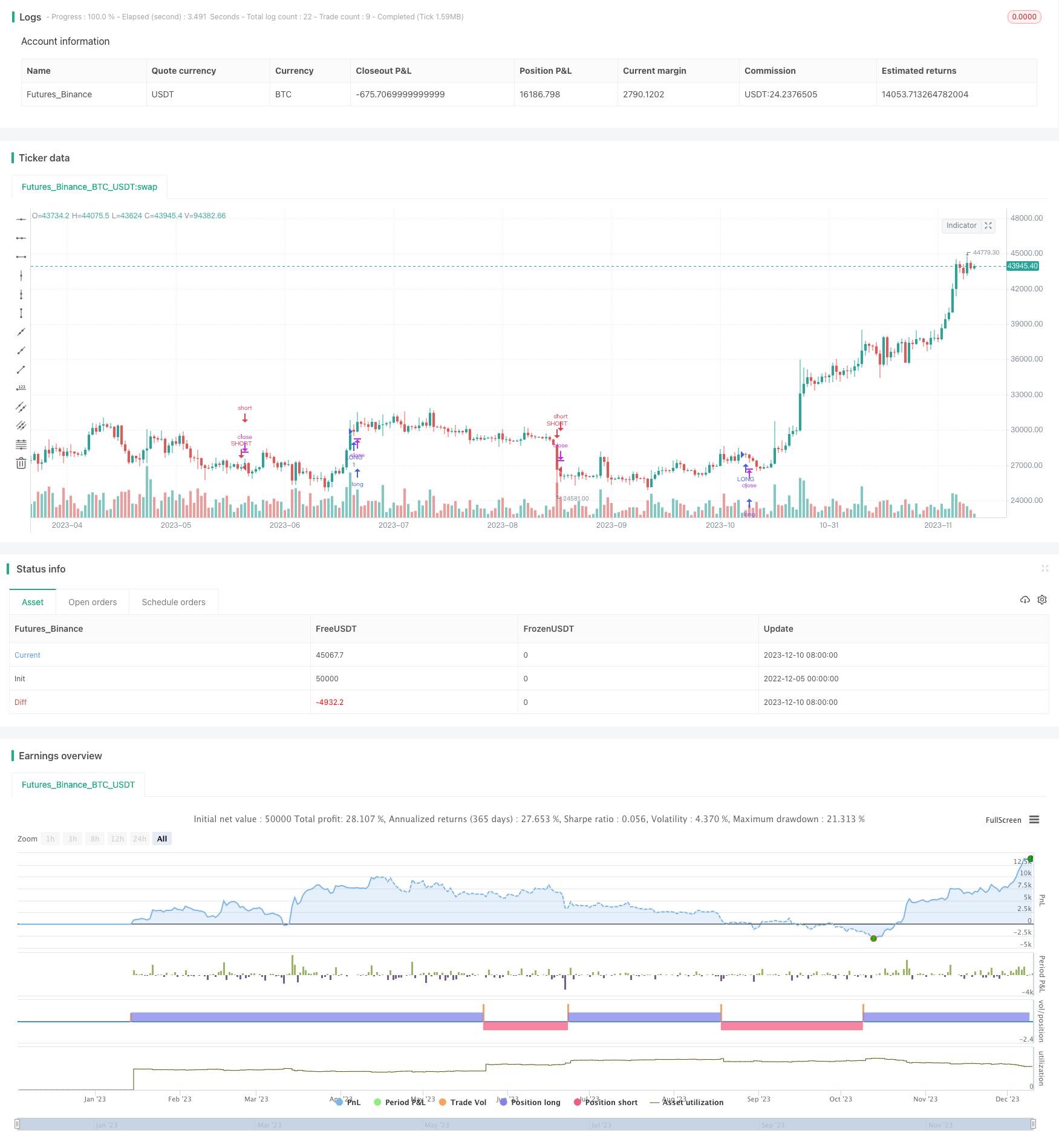
概述
本策略主要利用EMA移动平均线和MACD指标,判断行情分型的变化,进行追涨杀跌的操作。核心思路是当短期EMA线从下方突破长期EMA线而MACD同时上穿0轴向上时,做多;当短期EMA从上方突破长期EMA而MACD同时下穿0轴向下时,做空。
原理
该策略融合了移动平均线指标和MACD指标。
首先,它使用了两个不同长度周期的EMA指标,一个是25周期EMA线,一个是50周期EMA线。25周期EMA线能反映短期趋势,50周期EMA线能反映中长期趋势。当短期EMA线从下方上穿长期EMA线时,表示行情从下跌转为上涨,属于金叉信号,做多判断。当短期EMA从上方下穿长期EMA时,表示行情从上涨转为下跌,属于死叉信号,做空判断。
其次,该策略同时结合MACD指标判信号。MACD指标包括DIF线和DEA线,代表短期和长期指数平滑移动平均线的差值,通过双EMA算出。本策略设置DIF为12日EMA减26日EMA。DEA线为DIF的9日指数移动平均。DIF线代表动量,DEA线代表MACD的平均值。当DIF从下方上穿DEA线时产生买入信号。当DIF从上方下穿DEA时产生卖出信号。
综合这两个指标,当发生25日EMA金叉50日EMA,同时MACD的DIF线上穿DEA线时,产生买入信号,做多;当发生25日EMA死叉50日EMA,同时MACD的DIF线下穿DEA线时,产生卖出信号,做空。
优势分析
这是一个非常典型的双轨策略,同时结合MACD指标产生更可靠的交易信号,具有以下优势:
使用双EMA均线,能避免whipsaws现象和假突破,产生更可靠的交易信号。
融合MACD指标,能进一步验证交易信号,避免EMA双轨假信号的风险,提高策略的实战效果。
采用25和50日线作为快慢线,参数选择更为准确,能捕捉到中短线明显的趋势变化。
利用追涨杀跌思路,能跑赢大盘指数,在行情大幅上涨和下跌时获得较大收益。
策略逻辑简单清晰,容易理解和实施,适合量化初学者使用。
可谨慎适当优化参数,使策略更好地适应不同品种和行情环境。
风险分析
该策略也存在一些风险需要警惕:
EMA均线产生假信号的可能性依然存在,如遇剧烈行情,仍会出现whipsaw现象。
MACD指标参数需要不断优化和调整,否则会产生错误信号或者信号滞后。
需要警惕止损点设置是否合理,避免无效突破造成较大亏损。
需要关注行情和政策环境变化,避免系统性风险造成较大亏损。
需要控制仓位规模和杠杆水平,防止单边大行情爆仓。
优化方向
该策略还可以从以下几个维度进行优化:
测试更加准确和实战有效的参数组合,如测试20日和60日EMA均线作为交易轨,DIF为10日EMA和20日EMA差值等。
增加成交量指标的确认,避免低量假突破。
结合波动率指标如ATR确定更科学的止损方式。
利用机器学习算法自动优化参数,使策略参数动态适应市场环境变化。
增加仓位控制模块,让仓位规模可随交易表现和衡量指标动态变化。
可在更长周期的图表上绘制该策略信号,辅助决策更长线方向的操作。
总结
本策略整合了移动平均线指标和MACD指标的优点,通过双EMA均线判断质量比较高的K线分型,配合DIF和DEA判断MACD动量方向的匹配,形成了一个稳定、实战效果较好的追涨杀跌型量化策略。该策略逻辑简单清晰,易于理解和优化,非常适合量化学习者入门和实战。通过不断测试和优化参数,该策略可以成为跑赢指数的价值策略之一。
/*backtest
start: 2022-12-05 00:00:00
end: 2023-12-11 00:00:00
period: 1d
basePeriod: 1h
exchanges: [{"eid":"Futures_Binance","currency":"BTC_USDT"}]
*/
//@version=4
strategy(title="EMA+MACD", shorttitle="EMA+MACD", overlay=true)
// Getting inputs
fast_length = input(title="Fast Length", type=input.integer, defval=12)
slow_length = input(title="Slow Length", type=input.integer, defval=26)
src = input(title="Source", type=input.source, defval=close)
signal_length = input(title="Signal Smoothing", type=input.integer, minval = 1, maxval = 50, defval = 9)
sma_source = input(title="Oscillator MA Type", type=input.string, defval="EMA", options=["SMA", "EMA"])
sma_signal = input(title="Signal Line MA Type", type=input.string, defval="EMA", options=["SMA", "EMA"])
fast_ma = sma_source == "SMA" ? sma(src, fast_length) : ema(src, fast_length)
slow_ma = sma_source == "SMA" ? sma(src, slow_length) : ema(src, slow_length)
macd = fast_ma - slow_ma
signal = sma_signal == "SMA" ? sma(macd, signal_length) : ema(macd, signal_length)
hist = macd - signal
len1 = input(title="Len Ema 1 ",type=input.integer,defval=25)
len2 = input(title="Len Ema 2 ",type=input.integer,defval=50)
ema1 = ema(src,len1)
ema2 = ema(src,len2)
bull = crossover(ema1,ema2) and macd > 0
bear = crossover(ema2,ema1) and macd < 0
l1 = bull ? label.new(x=bar_index,y=low,yloc=yloc.belowbar,text="BUY",color=color.green,textcolor=color.white,style=label.style_triangleup) : na
l2 = bear ? label.new(x=bar_index,y=high,yloc=yloc.abovebar,text="SELL",color=color.red,textcolor=color.white,style=label.style_triangledown) : na
strategy.entry("LONG",strategy.long,when=bull)
strategy.entry("SHORT",strategy.short,when=bear)